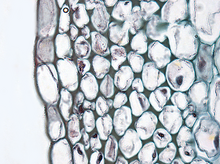Ground tissue
They have thin and flexible cellulose cell walls and are generally polyhedral when close-packed, but can be roughly spherical when isolated from their neighbors.In the spongy mesophyll of a leaf, parenchyma cells range from near-spherical and loosely arranged with large intercellular spaces,[2] to branched or stellate, mutually interconnected with their neighbours at the ends of their arms to form a three-dimensional network, like in the red kidney bean Phaseolus vulgaris and other mesophytes.Sclerenchyma fibers are of great economic importance, since they constitute the source material for many fabrics (e.g. flax, hemp, jute, and ramie).It is the hard, thick walls that make sclerenchyma cells important strengthening and supporting elements in plant parts that have ceased elongation.Their high load-bearing capacity and the ease with which they can be processed has since antiquity made them the source material for a number of things, like ropes, fabrics and mattresses.The fibers of flax (Linum usitatissimum) have been known in Europe and Egypt for more than 3,000 years, those of hemp (Cannabis sativa) in China for just as long.These fibers, and those of jute (Corchorus capsularis) and ramie (Boehmeria nivea, a nettle), are extremely soft and elastic and are especially well suited for the processing to textiles.Typical examples are the fiber of many grasses, Agave sisalana (sisal), Yucca or Phormium tenax, Musa textilis and others.[10] During evolution the strength of the tracheid cell walls was enhanced, the ability to conduct water was lost and the size of the pits was reduced.They are small bundles of sclerenchyma tissue in plants that form durable layers, such as the cores of apples and the gritty texture of pears (Pyrus communis).




ProtoxylemPhloembast fibreCortexEpidermisdermalvascularprimary wallspericyclemedullary rayslignifiedsecondary wallsAerenchymaparenchyma cellstrabeculaeendospermmeristematiccell divisioncellulosecell wallspolyhedralcentral vacuolesleavesphotosynthesispotatoescerealscotyledonspulsespeanutsSecretionresin ductsaerationstellatePhaseolus vulgarismesophytesepidermalguard cellsplant dermal tissueshootsceleryprimary cell wallvascular cambiumBletiaSchleidenplantssclereidshemicelluloseligninfabricsmattressesEuropenettletextilesmonocotsgrassesPhormium tenaxMusa textilisCambiumprocambiumcellulosictracheidsMetteniusSclereidapplesparenchymabrachysclereidsquinceswax plantdrupescherriesCampbell, Neil A.Reece, Jane B.Merriam-Webster.com DictionaryLexicoOxford University PressBotanyHistoryOutlineSubdisciplinesArchaeobotanyAstrobotanyBryologyDendrologyEthnobotanyPaleobotanyPhycologyPhytochemistryPhytogeographyGeobotanyPlant anatomyPlant ecologyPlant intelligencePlant pathologyPlant physiologyArchaeplastidaBryophyteNon-vascular plantsVascular plantsLycophyteSpermatophytesGymnospermAngiospermPlant morphologyglossaryPlant cellsCell wallPhragmoplastPlastidPlasmodesmaVacuoleTissuesMeristemStorage organsVascular tissueVascular bundleRhizoidRhizomeCataphyllPetioleSessilityReproductiveArchegoniumAntheridiumAndroeciumPollenStamen